By Eric Vandenbroeck
9 Oct. 2019
US. and Kurdish
officials said late Tuesday that they expect Turkey to launch a major offensive
into northeast Syria within the next 24 hours, after U.S. President Donald
Trump appeared to give Ankara the green light to begin the operation.
Whereby early in the
morning today reports have come in that Turkish troops have begun crossing
Into Syria.
The Syrian Democratic
Forces (SDF) who operate in the area are US allies. They are led by the Kurdish
People's Protection Units (YPG), which Turkey considers a terrorist
organization. Trump's decision to pull troops from the area cleared the way for
Turkey to attack.
The scale and size of
a potential Turkish operation remain unclear. Officially Turkey wants to create
a 32-kilometer-deep, 480-kilometer-long corridor (20 miles deep, 300 miles
long) inside Syria along the border to protect its security.
A Turkish military incursion into northeast Syria would likely send hundreds of thousands of civilians
fleeing into SDF-controlled areas further south and into neighboring Iraqi
Kurdistan.
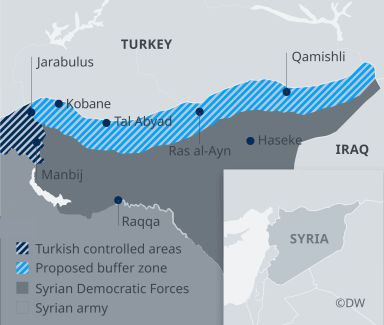
Who are the Kurds?
A subject I have covered in a different context before, the Kurds live under the rule of several states that
succeeded the Ottoman Empire: the Republic of Turkey, Syria, and Iraq. Kurds
also lived in large numbers in Persia or Iran, and there were smaller Kurdish
populations in Russia and Lebanon. Their population statistics were disputed
because of the states where Kurds lived tended to minimize their numbers, but
Kurds made up some 20 percent of the population of Turkey, more than 20 percent
of the population of Iraq, and close to 10 percent of the population of Iran.
With a total population of some 24 million to 27 million by the late twentieth
century, Kurds made up the largest ethnic group without a state in Europe or
Western Asia.
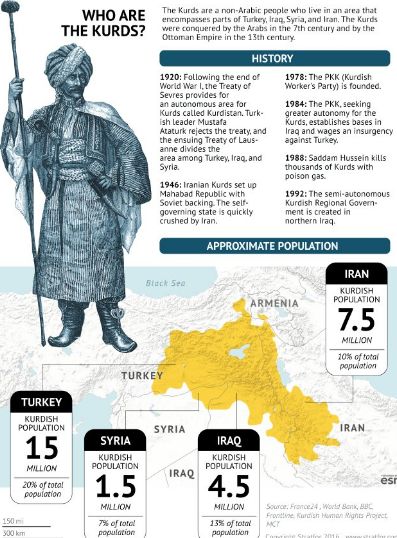
Kurdish identity,
society, and politics have been heavily influenced by the state-building
projects of the countries within which they live. As a result, while many
Kurdish nationalists may dream of a greater independent Kurdistan, Kurdish
political parties’ demands for greater rights and autonomy have traditionally
been directed towards the states within which they live, even as Kurdish
movements in one part impact those in another part.
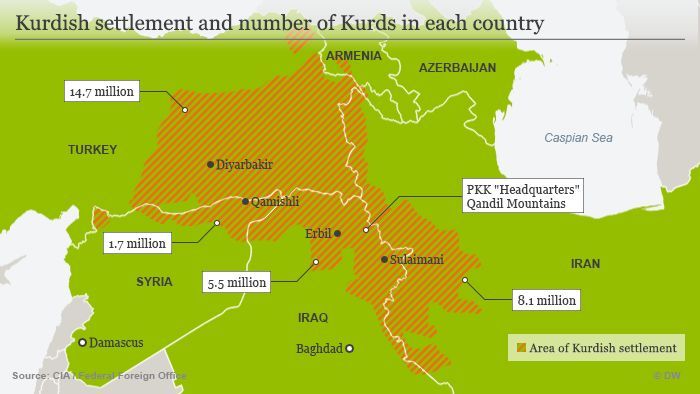
Rojava, as the Syrian
Kurds call the area they gained control of when the Syrian army largely
withdrew in 2012, and which now stretches across northern Syria between the
Tigris and Euphrates. Whereby in Iraq, the Kurdistan Regional Government (KRG),
already highly autonomous, took advantage of ISIS’s destruction of Baghdad’s
authority in northern Iraq to expand its territory, taking over areas long
disputed between itself and Baghdad, including the Kirkuk oilfields and some
mixed Kurdish-Arab districts.
Turkey has been
appalled to find that the Syrian uprising, which it hoped would usher in an era
of Turkish influence spreading across the Middle East, has instead produced a
Kurdish state that controls half of the Syrian side of Turkey’s 550-mile
southern border. Worse, the ruling party in Rojava is the Democratic Union
Party (PYD), which in all but name is the Syrian branch of the Kurdistan
Workers’ Party (PKK), against which Ankara has been fighting a guerrilla war
since 1984. In the year since ISIS was finally defeated in the siege of the
Syrian Kurdish city of Kobani, Rojava has expanded territorially in every
direction as its leaders repeatedly ignore Turkish threats of military action
against them.
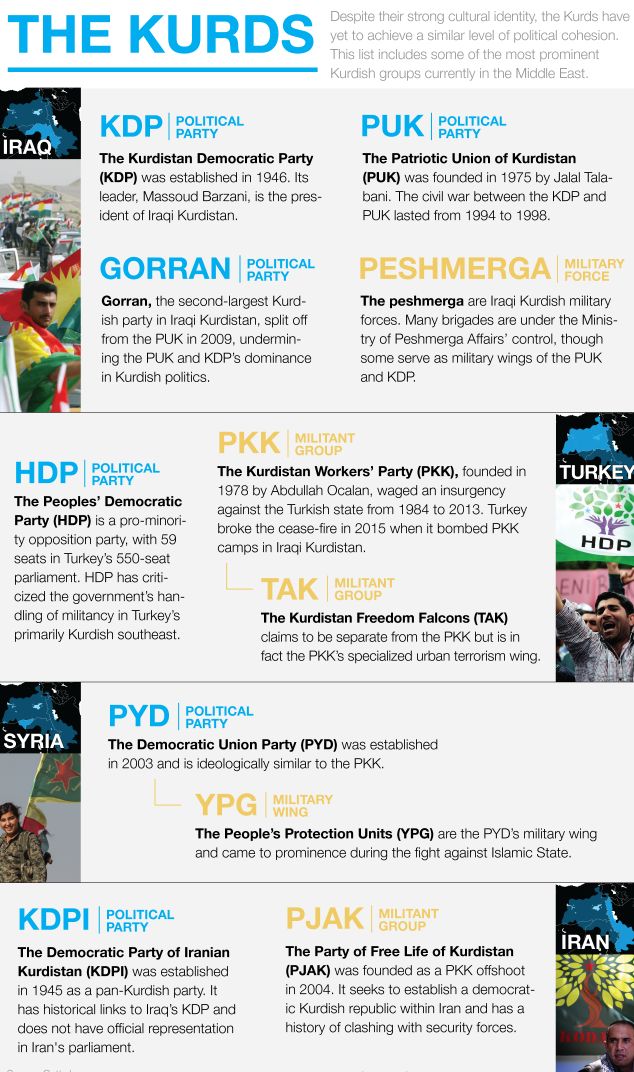
For the Kurds in Rojava
and KRG territory this is a testing moment: if the war ends their newly won
power could quickly slip away. They are, after all, only small states, the KRG
has a population of about six million and Rojava 2.2 million, surrounded by
much larger ones. And their economies are barely floating wrecks. Rojava is
well organized but blockaded on all sides and unable to sell much of its oil.
Seventy percent of the buildings in Kobani were pulverized by US bombing.
People have fled from cities like Hasaka that are
close to the frontline. The KRG’s economic problems are grave and probably
insoluble unless there is an unexpected rise in the price of oil.
The following map shows on the left Kurdish “Rojava”
and on the right the Kurdistan Regional Government (KRG) in Iraq and Syria.
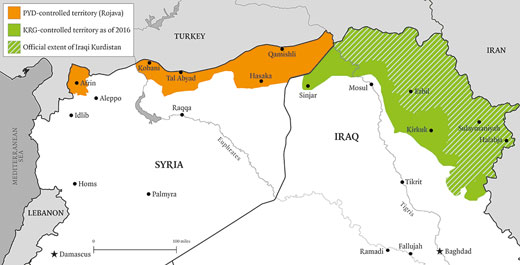
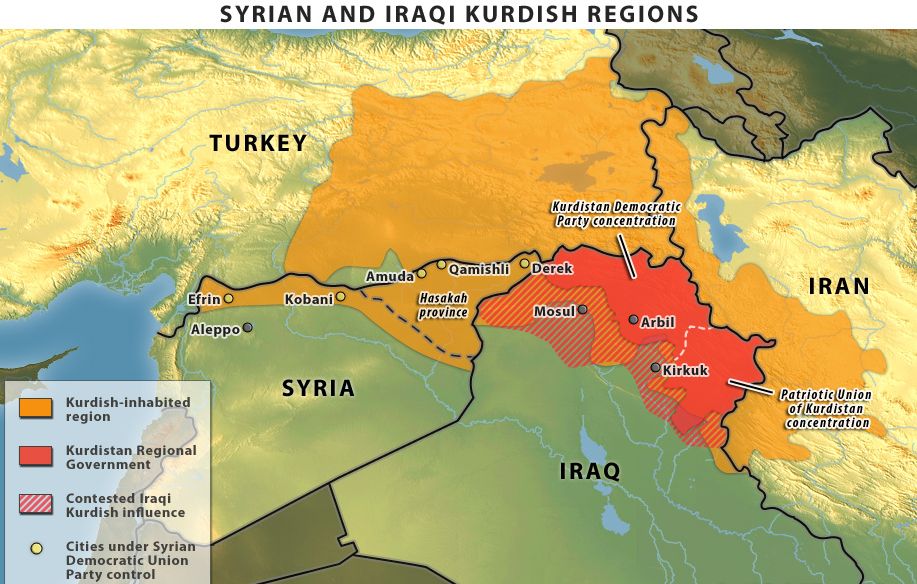
What is with Turkey and Erdogan in this matter?
Turkey’s playbook in
Syria has changed dramatically since the civil war broke out in 2011. Erdogan
was flying high at home that spring when people first took to the streets of
Damascus to protest the regime of Syrian President Bashar al-Assad. The
secularist opposition was in a slump, and Erdogan was set to embark on a
program to Islamize the country’s education system. The conflict across the
border in Syria offered Erdogan an opportunity to extend his agenda outward.
Within months, the Turkish government abandoned Assad, formerly a close
partner, and began to arm the Islamist insurgents doing battle against
Damascus. Turkey soon became a hub for Syria’s exiled opposition and a conduit
for the steady stream of foreign jihadi fighters making their way into Syria.
Eventually, Ankara turned a blind eye even to members of the Islamic State (or
ISIS), who slipped in and out of the country and sometimes sought medical
treatment there. All the while, Turkey opened its borders to millions of
refugees fleeing the fighting and built vast camps to hold the new arrivals.
The gesture was expensive but morally just, Erdogan argued, an act of Sunni
compassion and solidarity in the face of the Assad regime’s atrocities. That
narrative struck a chord with the public, and opposition to the refugee influx
remained relatively muted. All told, Turkey hosted 3.6 million Syrian refugees.
Fighting in Syria,
however, were not just Islamist insurgents but several Kurdish militias. For
Erdogan, this was bad news. In 2015, his Justice and Development Party had lost
its parliamentary majority for the first time in over a decade, owing in part
to the unexpected success of a party representing Turkey’s Kurdish minority,
parts of which had for decades fought their own low-level insurgency in the
country’s southeast. To hold on to power, Erdogan struck an alliance with a far-right
opposition party known for its strong opposition to Kurdish nationalism. The
government’s years-long peace process with Kurdish militants in the southeast
came to an abrupt end.
Erdogan’s priorities
in Syria shifted accordingly. Ankara was now determined to discourage Kurdish
efforts to establish autonomy in the region spanning southeast Turkey and
northern Syria. Attempts to unseat Assad through Islamist proxies took a back
seat to the more pressing concern of denying the Syrian Kurds a contiguous
autonomous region along the border with Turkey. In Aleppo, the Syrian rebels’
last stronghold, Turkey now enlisted insurgents who had been fighting Assad to
attack Kurdish forces instead, sapping the rebellion of its manpower and
facilitating the advance of the Syrian army, which retook the city in 2016.
That year, Turkey sent its own military into northern Syria in an effort to
contain the Kurdish militias operating there.
By 2017, Erdogan’s
about-face was complete, and Ankara was working with the Assad regime and its
allies. To the dismay of the Syrian opposition, Turkey, Russia, and Iran agreed
to create several so-called de-escalation zones. In theory, regime and
opposition in these areas would have to honor limited cease-fires, but in
practice, the regime made military gains by frequently violating the truces,
often with Russian support. In return, Damascus and its allies looked the other
way when Turkey launched a second military intervention into the Kurdish
enclave of Afrin in January 2018.
Just as Erdogan’s
domestic concerns about Kurds occasioned a shift in his objectives in Syria, so
too have domestic concerns about refugees. The Turkish president senses that
his open-door policy has become a domestic liability. His party lost control of
almost all major cities in the 2019 municipal elections—an immense blow to the
city-level patronage system upon which Erdogan built his power over the last 25
years. The rout owed something to the deepening economic crisis, but it also
reflected growing public discontent with the 3.6 million Syrian refugees still
in the country.
Once the
self-proclaimed magnanimous patron of all Sunnis, Erdogan now wants the
refugees to go home. Turkish authorities have stepped up house searches and
arrests of Syrian refugees. The state has tried to move refugees out of the
major cities, and the police have set up a hotline to collect information on
those who enter the country illegally. Some have reportedly been deported to
the Syrian city of Idlib, even as the fighting there intensifies.
Once the
self-proclaimed magnanimous patron of all Sunnis, Erdogan now wants the
refugees to go home.
Forcing hundreds of
thousands, perhaps even millions, of Syrian refugees out of the country and
back into a war zone is nearly impossible, but Erdogan thinks otherwise. His
solution, recently laid out in a speech at the UN General Assembly, is to carve
out a large buffer zone along Syria’s border with Turkey. The area would be 300
miles long and 20 miles deep, under Turkish control, and off-limits to Kurdish
forces. According to Erdogan, this “safe zone” would host two million to three
million refugees, thus ridding Ankara of a major domestic headache. It would
boast 200,000 homes, along with hospitals, football pitches, mosques, and
schools, Turkish-built but financed internationally—a setup that would provide
much-needed revenue for Turkey’s struggling construction sector at a time of
economic downturn. Securing funding for this idea is a tall order, but Erdogan
is willing to push the envelope. In September, he threatened that he would
“open the gates” and set off another European refugee crisis if he did not get
his way.
Erdogan’s proposal might
be the perfect solution for his domestic woes, but it is sure to create a host
of new problems for everyone else. His plan would send millions of Arab Syrian
refugees into Kurdish-majority areas inside Syria, not incidentally, from
Erdogan’s point of view, as changing the ethnic makeup of the region would
further undermine the Kurds. But doing so would increase Arab-Kurdish tensions,
fuel conflict in a region that has been relatively stable, and cause mass
displacement in those areas. Under international law, Erdogan cannot force the
Syrian refugees to move back, and most would almost certainly not move
voluntarily, even into a purported safe zone. U.S. strategy in Syria, which has
relied heavily on the Kurds to prevent ISIS from making a comeback, would take
a massive hit. And the plan is a godsend to the United States’ adversaries in
Syria—Russia, Iran, and the Assad regime—who believe they can stand by while
the Turkish incursion prompts a complete U.S. withdrawal, only to recapture the
area and kick out Turkey later on.
What next?

While his troops have
started to move, Erdogan will visit the United States on 13 Nov. at Trump's
invitation, a White House spokesman said. He announced on Monday that U.S.
troops had started to withdraw after a phone call he had with Trump.
Trump's decision to
withdraw troops from northeast Syria has rattled allies, including France, one
of Washington's main partners in the U.S.-led coalition fighting Islamic State.
Even Republican
Senator Lindsey Graham of South Carolina, usually one of Trump’s staunchest
defenders, has threatened to sanction the Turkish government if it sets foot in
Syria. Erdogan, however, is likely prepared to take that risk. His rule is at
stake, and that is all that matters to him, even if it means economic penalties
for his country and yet more chaos and suffering for Syria.
Thus Kurdish leaders
are now scrambling to prepare for the worst. Gen. Mazloum Kobani, the top SDF
general, announced amid the haze of strategic surprises, diplomatic
miscommunication, and public backpedaling, that an alliance with Assad against
Turkey is “on the table.” The SDF is “ready” for talks with Assad, SDF-affiliated diplomat Sinam Mohamad told the National Interest. But Assad’s two
main backers, Russia and Iran, are towing a careful line.
The Rojava
Information Center, a media organization based in northeast Syria, confirmed to
the National Interest that pro-Assad forces are massing near Manbij and Deir ez-Zour,
but it’s not clear whether they will help or hinder the Turkish campaign. David
Ignatius, a Washington Post columnist, claimed that Assad was mobilizing his forces for an invasion of his own.
Russian foreign
minister Sergei Lavrov condemned U.S. support for the SDF, but also left the door open
for a Kurdish role in Syrian politics.
“The Americans have
established quasi-government structures there, keeping them functional and
actively promoting the Kurdish issue in a way to cause dissent among the Arab
tribes traditionally populating these territories,” he said, according to
Russian state media. “Our stance unequivocally proceeds from the need to solve
all problems of that part of Syria through dialogue between the central
government in Damascus and representatives of the Kurdish communities that have
traditionally lived in these territories.”
According to Fawri Hariri, an Iraqi Kurdish official who met with Lavrov, the Russian foreign minister promised to help
mediate between Damascus and the Kurds.
Given there earlier
pattern Russia is likely to try to reach arrangements with everybody involved.
Whereby Iran’s
established position has been to encourage the Kurds to reach a kind of
compromise with Assad to prevent any kind of Turkish invasion in that part of
Syria.
Late on Tuesday,
Iranian foreign minister Javad Zarif condemned any Turkish military action, but
also brought up the Adana Agreement of 1999. In the pact, Syria had agreed to
cut off its support for Kurdish guerrillas in Turkey and expel Kurdish
nationalist leader Abdullah Öcalan.
Azizi explained the
comments as a “shift in Iran’s position from trying to reach the compromise
between the Kurds and Damascus to trying to reach a compromise between Turkey
and Damascus.”
“I think [Russia]
wouldn't be happy with a major offensive, but at the same time, if there was a
smaller incursion, they would not be as opposed to it as they publicly state,”
Signaling a further
potential shift in the region's power balance, the Kurdish-led forces said they
might start talks with the Syrian government and Russia to fill a security
vacuum.
The SDF, which has
vowed to defend itself against any perceived Turkish incursion, called on the
US-led coalition and the international community to implement a no-fly zone
over northern Syria similar to the one implemented in Iraq.
But the latter is not
happening for example at the time of writing heavy smoke was seen billowing
from an SDF position, hit by Turkey airstrikes on the outskirts of Ras Al Ayn:
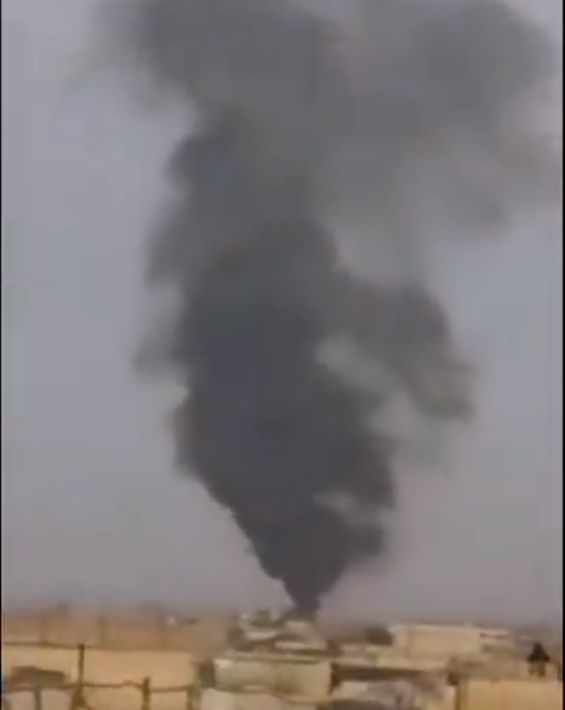
With many people seen flying Ras Al Ayn:
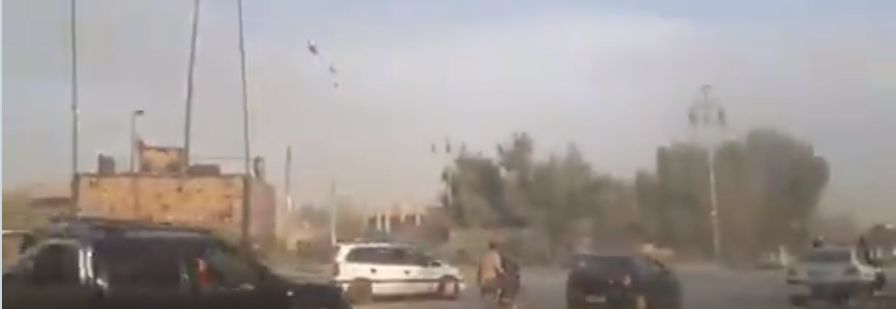
Civilians are also fleeing several other places like,
as seen next, the border town of Serekanyie as
Turkish warplanes and artillery target positions of the Kurdish forces.
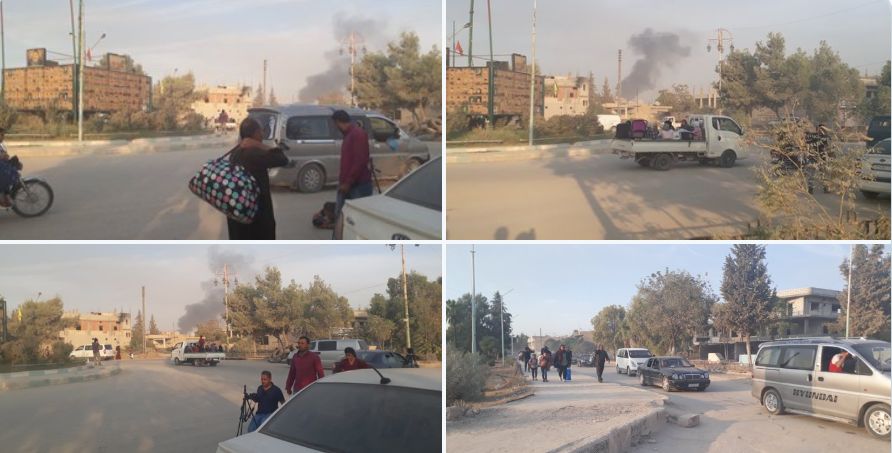
The
Turkish Army is also bombarding SDF positions in Qamishli City, where hundred of thousands of civilians live.
What happens in the
longer term depends on whether the US keeps a military presence in other parts
of the northeast and east.
A full withdrawal
could expose the area to the risk of more Turkish advances, an IS revival, or
attempts by Iranian- and Russian-backed government forces to gain ground.
As evening fall today:

For updates
click homepage here